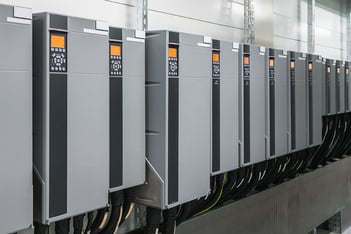The manufacturing industry values variable frequency drives (VFDs) to maximize efficiency and productivity, but that appreciation may slip away when a breakdown occurs. A seamlessly functioning VFD delivers tremendous benefits, but it can falter when not adequately maintained. And when a production line or machinery grinds to a halt as a result, it’s essential to troubleshoot the issues and quickly resume operations.

5 essentials of VFD maintenance
To maximize VFD life expectancy, it’s crucial to support reliability through a proactive maintenance plan. Such programs are tasked with underscoring the two foundational principles of reliability.
- Enhancing failure-free conditions for the VFD
- Increasing the probability the VFD will enjoy uninterrupted function under proper conditions.
For these principles to become a daily reality, it’s essential to understand the common failures and how they occur. These issues include as reflected harmonics, energy spikes, bearing problems and inadequate temperature controls.
In order to avoid having a VFD falter, it will be necessary to conduct the five following maintenance essentials.
-
- Keep the VFD clean: Commercial and industrial environments commonly include airborne dust and debris and can negatively impact a VFD. According to FactoryMation, regardless of the VFD chassis type, “It is critical that the heat sink and fans are kept clean.” It’s recommended to periodically wipe, clean and air spray all accumulations from the VFD.
- Maintain VFD temperatures: It’s not unusual for VFDs to be housed in enclosures that may experience heat spikes. Include temperature control systems and appropriate air circulation.
- Prevent moisture penetrations: Water and electricity do not mix well in industrial settings. Moisture will inevitably cause corrosion, erratic behaviors, and equipment failures. Keep the equipment dry.
- Maintain tight connections: Vibrations tend to loosen electrical connections over time. This may result in uneven VFD functions. Check the connections as part of an ongoing maintenance plan.
- Conduct visual inspections: The first step to proactive maintenance is to visually inspect VFDs weekly. Have maintenance personnel look for the above-mentioned issues and others that could impact VFD operations. Key elements to visually inspect include the connections, fiber optic cables, emergency circuits, and area cooling systems, among others.
5 VFD troubleshooting tips to consider
 While the best way to ensure a VFD does not needlessly falter is proactive maintenance, breakdowns remain
While the best way to ensure a VFD does not needlessly falter is proactive maintenance, breakdowns remain
an industry reality. These may be caused by not recognizing environmental effects on machinery, hard impacts
or other unforeseen circumstances. Industry leaders understand every minute an operation is not functioning
at full capacity results in losses. These five VFD troubleshooting tips can help get companies back online.
- Check diagnostics display: Today’s VFDs routinely come equipped with troubleshooting functions. The display module can indicate
issues such as overheating, irregular voltage, or even a popped fuse. This is often the best place to begin troubleshooting. - Check for moisture: Without making physical contact, take a visual inventory of the machinery and look for moisture accumulations.
Water can cause shorts and other damage. Take safety precautions, and do not touch any electrical equipment that may have
gotten wet. - Check for dust: If the VFD has not been thoroughly cleaned, it may have grit accumulations inside that caused a malfunction.
In such cases, it may be necessary to remove the unit and replace it until the affected VFD can be cleaned and reinstalled.
Organizations are wise to have backups in the event of a significant breakdown or issue. - Check VFD connections: While wearing appropriate safety equipment, visually and physically check for loose connections.
If the VFD seemed to be delivering uneven output recently, cable or connection problems may be the culprit. - Resonance testing: When vibrations place undue stress on equipment, they tend to become increasingly unreliable. Issues may
include impacted welds, and loose bolts, among others. Consider running a diagnostic test to see if the VFD is operating in what is
called an “excited state” as a result of resonance. This troubleshooting effort could save you from conducting repeat maintenance
and replacement.
A properly maintained VFD can provide decades of cost-effective service. Like any piece of equipment, though, that depends on maintenance and care.
Making VFD inspections and maintenance part of facility oversight can improve outcomes.
To learn more about how Radwell can assist you with your Variable Frequency Drive maintenance and repairs
For a behind the scenes look at Radwell products and services
View the original article and related content on Control Engineering


